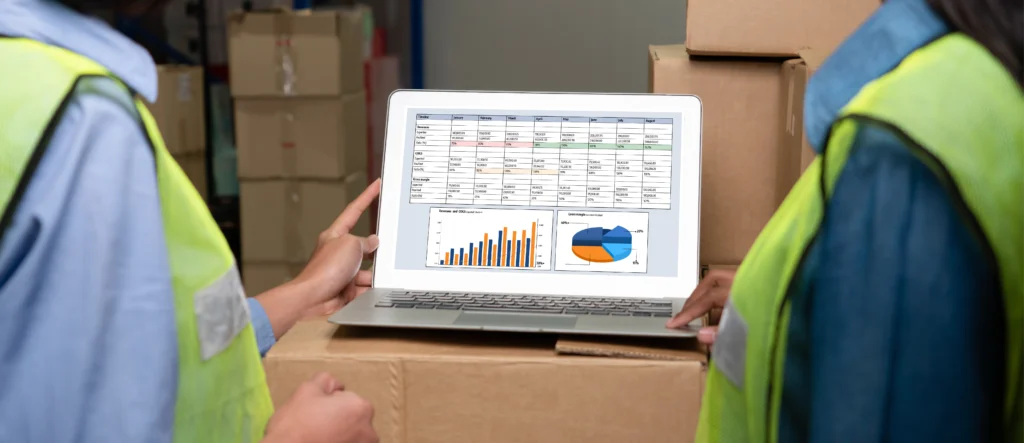No importa el tamaño o el giro de un negocio; prácticamente todos deben ser capaces de generar y gestionar reportes financieros y de balance de inventarios.
Los primeros como parte del régimen de cumplimiento legal y fiscal, mientras que los segundos son necesarios para:
- Vender mejor
- Mantener la eficiencia en los procesos
- Evitar el rompimiento de stocks
- Evitar pérdidas
- Y por ende, ahorrar dinero
Hay datos que muestran que las empresas que gestionan correctamente sus reportes y balance de inventario logran reducir hasta en 50% el tiempo de sus entregas con el consecuente ahorro de dinero y satisfacción de sus clientes.
Pero hay más; de acuerdo con Asset Infinity la administración eficiente de los balances de inventario sirve para reducir entre el 10 y el 25% el desabastecimiento de las existencias.
Más sobre temas de logística e inventarios, conoce ¿Qué es la U.V.A. (Unidad de Verificación Autorizada) y cuál es su labor?
¿Qué es el reporte de balance de inventarios?
Un balance de inventarios es un registro físico o digital que contiene la cantidad total de existencias que posee un negocio a la mano, en almacén y en stock al alcance de los clientes.
Este reporte incluye datos como los productos más vendidos y permite administrar, ubicar y categorizar la mercancía.
Para IBM los usuarios más frecuentes de un balance de inventarios son:
- Gerentes de almacén
- Supervisores de logística
- Analistas de inventarios
- Y usuarios empresariales
Quienes utilizan el reporte de balance de inventarios para conciliar existencias comparándolo y sincronizando con los movimientos del día a día.
Ese registro evita quedarse sin existencias o comprar de más y puede ser de varios tipos porque el reporte de balance de inventarios es un documento que reúne varios inventarios parciales.
No solo el de los productos más o menos vendidos, sino además el de la mercancía que más genera ganancias, el del precio de cada existencia y el inventario de pronóstico que permite saber cuánta mercancía se necesitará para satisfacer las compras de los clientes en el futuro.
Una excelente estrategia para optimizar tus inventarios es elegir la logística adecuada, conoce cómo elegir un operador 3PL para tus importaciones y exportaciones.
¿Para qué se utiliza un reporte de balance de inventarios?
Un reporte de inventarios se utiliza para tres fines principales:
Administrar el inventario
Su negocio debe saber qué tiene en almacén y en stock para no quedarse sin existencias antes de haber cumplido las órdenes de compra o de lo contrario tendrá pérdidas, en lo que se conoce como rompimiento de stock.
Por otra parte, almacenar demasiada mercancía aumenta el costo de inventario y la posibilidad de su pérdida por siniestro, robo u obsolescencia.
Precisamente, el reporte de inventario sirve para saber cuánta y cuándo comprar mercancía nueva.
Ubicar la mercancía
Un balance de inventario actualizado permite saber dónde está cada unidad de mantenimiento de existencias (SKU o Stock Keeping Unit, por sus siglas en inglés) lo que redunda en ahorros, ya que se necesitan menos movimientos para ubicar la mercancía.
Adicionalmente el reporte de inventario sirve para conocer la ubicación de ítems:
- Comprados por fecha
- Comprados por un proveedor específico
- Devueltos
- Excluidos o desincorporados por alguna razón
Categorización del inventario
Un balance de inventarios actualizado permite seguir los ítems a través de la cadena de suministro y también identificar el costo de los bienes vendidos con fines tributarios y de contabilidad.
Por si te interesa, te traemos la guía del depósito fiscal en México.
¿Cómo crear un balance de inventarios?
Aunque pueden usarse hojas de cálculo de Excel para realizar cualquier reporte de inventarios, lo ideal es usar programas que vinculen las entregas de los proveedores y los pedidos de los clientes en una plataforma que se actualice automáticamente, como por ejemplo un ERP.
Sin embargo, aquí ofrecemos los pasos para realizar un balance de inventarios de forma manual o en hoja de cálculo para un pequeño negocio:
1) Crea una columna para los ítems del reporte de inventarios
Este paso consiste en listar cada SKU en una columna vertical.
2) Crea una columna para las descripciones
En esta otra columna se ofrece una descripción adicional de cada SKU.
3) Asigna precio a cada ítem
Aquí se lista el precio de cada ítem incluido en las dos columnas anteriores. Según el tipo de negocio podría ser necesario identificar por separado el costo de compra o de manufactura del precio de venta.
4) Crea una columna para la actualización del balance de inventario
Aquí se actualiza lo que existe en el inventario luego de comparar las nuevas órdenes de compra con las órdenes de venta.
5) Selecciona un período para actualizar el balance de inventario
Este paso dependerá de las necesidades del negocio. Por ejemplo, mientras mayor sea el volumen de ventas más frecuentemente se necesitará su actualización.
El dominio en inglés ShipBop ofrece otros tips para crear un reporte de inventarios.
Entérate de qué se trata el Fulfillment y los pasos para hacerlo correctamente.
¿Cómo sacar provecho de los reportes de inventarios?
Aunque los reportes de balance de inventarios son útiles en todas las áreas de un negocio, pueden ser más provechosos en estas:
Control y trazabilidad
En los negocios en los que se improvisa se pierde dinero, por eso los reportes de inventario requieren un plan logístico que fije:
- Fechas
- Plazos
- Frecuencias
- Ubicación
- Y personal
Para las actividades que hemos mencionado.
El correcto surtido de todo SKU

Las SKU deben distribuirse entre el almacén y el stock al que acceden los clientes en una estrategia llamada de ‘niveles pares’ que permite el flujo ininterrumpido de las ventas.
También es posible redistribuir los ítems del almacén bajo un reporte A-B-C:
- Zona A: Los primordiales, entre un 15 o 20% de las existencias que concentran el 70-80% del valor del inventario.
- Zona B: De importancia relativa, 20%- 15% de los ítem que concentran 20-15% del valor.
- Zona C: Misceláneos o triviales, 60-70% de los ítem que representarán a lo sumo un 20% del valor del inventario.
De manera que los sitios más accesibles del almacén estarán aquellos ítems de mayor valor, ganancia o rotación.
Posibilita el conteo en almacén
Una buena administración del balance de inventarios ahorra tiempo, entre otras cosas porque permite el conteo en el almacén y esto significa mayor productividad de los trabajadores.
Adecuado tratamiento de la mercancía próxima a caducarse o caduca
Esto es relevante sobre todo cuando el inventario está formado por bienes perecederos o cuando su costo fluctúa regularmente, condiciones que se expresan en las reglas PEPS (primero en entrar – primero en salir o FIFO, por sus siglas en inglés) y UEPS (último en entrar – primero en salir; LIFO, por sus siglas en inglés).
Las reglas de inventario FIFO aplican a productos que expiran o se vuelven obsoletos, mientras que las LIFO sirven para evitar pérdidas en bienes no perecederos, pero que fluctúan en precio por lo que hay que usar los precios actuales para calcular el costo.
Reporte de Balance de Inventarios – Para Finalizar
Los reportes de balance de inventarios son necesarios en todo tipo de negocio sin importar su tamaño o giro, aunque es vital en los que se dedican al eCommerce y las ventas al detalle.
Gracias a su correcta gestión se ahorra dinero y se construye lealtad en los clientes, que confiarán en aquellos vendedores que le otorgan siempre el surtido que necesitan.
Finalmente, si deseas un servicio logístico integral ABC Logística puede ser el aliado para tus negocios en México, contamos con depósito fiscal certificado y autorizado por el SAT, la autoridad nacional en materia de aduanas e impuestos.
¡Escala tus operaciones en México con el apoyo de los mejores en logística nacional e internacional!





